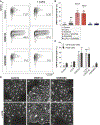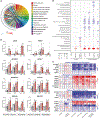PPARdelta activation induces metabolic and contractile maturation of human pluripotent stem cell-derived cardiomyocytes
- PMID: 35325615
- PMCID: PMC11072853
- DOI: 10.1016/j.stem.2022.02.011
PPARdelta activation induces metabolic and contractile maturation of human pluripotent stem cell-derived cardiomyocytes
Abstract
Pluripotent stem-cell-derived cardiomyocytes (PSC-CMs) provide an unprecedented opportunity to study human heart development and disease, but they are functionally and structurally immature. Here, we induce efficient human PSC-CM (hPSC-CM) maturation through metabolic-pathway modulations. Specifically, we find that peroxisome-proliferator-associated receptor (PPAR) signaling regulates glycolysis and fatty acid oxidation (FAO) in an isoform-specific manner. While PPARalpha (PPARa) is the most active isoform in hPSC-CMs, PPARdelta (PPARd) activation efficiently upregulates the gene regulatory networks underlying FAO, increases mitochondrial and peroxisome content, enhances mitochondrial cristae formation, and augments FAO flux. PPARd activation further increases binucleation, enhances myofibril organization, and improves contractility. Transient lactate exposure, which is frequently used for hPSC-CM purification, induces an independent cardiac maturation program but, when combined with PPARd activation, still enhances oxidative metabolism. In summary, we investigate multiple metabolic modifications in hPSC-CMs and identify a role for PPARd signaling in inducing the metabolic switch from glycolysis to FAO in hPSC-CMs.
Keywords: PPAR signaling; cardiac maturation; fatty acid oxidation; metabolism; stem cells.
Copyright © 2022 Elsevier Inc. All rights reserved.
Conflict of interest statement
Declaration of interests The authors declare no competing interest.
Figures







References
-
- Ascuitto RJ, and Ross-Ascuitto NT (1996). Substrate metabolism in the developing heart. Semin. Perinatol. 20, 542–563. - PubMed
-
- Barger PM, and Kelly DP (2000). PPAR signaling in the control of cardiac energy metabolism. Trends Cardiovasc. Med. 10, 238–245. - PubMed
-
- Barrie SE, and Harris P (1977). Myocardial enzyme activities in guinea pigs during development. Am. J. Physiol. 233, H707–H710. - PubMed
Publication types
MeSH terms
Substances
Grants and funding
LinkOut - more resources
Full Text Sources
Molecular Biology Databases

